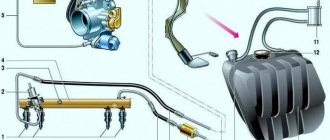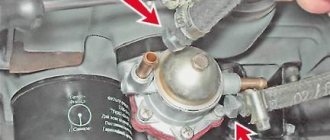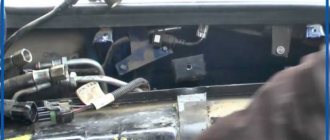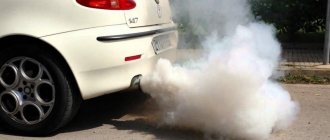Any driver can encounter an unpleasant odor in the car interior. Sometimes you may smell burnt oil in the cabin. This situation must be prevented, as it indicates problems with the engine. In addition, the smell of burnt oil is extremely harmful to the human body. Using different flavors of flavorings will help muffle the unpleasant odor, but they will not completely solve the problem.
A burning smell in the car interior may occur after recent work on changing oils and fluids in the engine compartment. Photo: okeydrive.ru
Where can the unpleasant smell of burnt oil come from in the cabin?
Typically, the smell of burnt oil enters the car interior through the air ducts of the ventilation system, the entrance to which is located above the engine compartment. It is most clearly felt after the engine has warmed up, with the cabin fan turned on and the recirculation mode turned off. Odor can also come through:
The main reasons for the appearance of odor in the cabin: video
- pedal assembly;
- central tunnel in the area of the gearshift lever drive;
- door seals;
- slightly open windows.
The persistent smell of burnt oil in the cabin clearly indicates a technical malfunction of the engine , less often the transmission and attachments. Their sources are usually localized in the engine compartment, so you can smell the burning smell by looking under the hood after the engine has warmed up.
The smell of burnt oil in the vehicle interior can come from the exhaust system or components of the transmission and all-wheel drive system located under the interior floor. If you don’t feel it when you open the hood, you should look for the problem in a pit, overpass or lift.
Burnt smell from clutch
The clutch is a car part that operates under conditions of constant and intense friction. The clutch is subject to constant load, both when the car starts moving and when the engine runs at high speeds.
One of the reasons for the burning smell may be the clutch, for example, in the process of slipping. The source of the smell may be the friction linings of the clutch disc. The smell will be reminiscent of burnt paper because... Friction linings are a paper-based composite material.
Don’t panic right away; this only means that during friction the friction linings have heated up and oxidized a little. Over time, they will recover and the clutch will still work for a very long time. Complete wear of the clutch is not accompanied by a burning smell. The main thing is not to let the engine run for a long time at high speeds (for example, slipping or prolonged acceleration in a low gear) and then the clutch of your car will last a long time.
Why does the cabin smell like burnt oil?
Repeated occurrences of a persistent burning smell in the cabin are a sign that the lubricant is getting on the hot walls of the cylinder block, the exhaust system and/or adjacent components. Most often this is due to engine problems . The most likely reasons why an oil smell may appear in the cabin are listed in the table:
| Probable Cause | Characteristic signs | Cause of the problem |
| Wear of oil seals | Oil leaks in the crankshaft area, most often from the timing drive side. | High oil level, increased crankcase gas pressure. |
| Wear of oil scraper rings | Oily spark plugs, blue smoke and oil smell from the exhaust pipe. | Untimely oil change, engine overheating, natural wear of the CPG. |
| Clogged or depressurized breather | Oil leaks in the area of the pipe or valve cover gasket, cracking of the hose. | Irregular cleaning of the breather, excessive oil runs. |
| Low oil volume in the crankcase | The “oil can” indicator is on or the oil level on the dipstick is low. | Lack of oil, leak, burnout in the engine. |
| Leaking valve cover or cylinder head gaskets | Oil leaks between the cover and the cylinder head or between the head and the cylinder block. | Worn or incorrectly installed gaskets. |
| Crankcase gas outlet | Oiling in the area of the pipe and hose, breather, oil filler neck, valve cover. | Clogged ventilation system, worn piston rings. |
| Oil leak through turbine | Oil contamination of the throttle valve and intake manifold or blue smoke and oil smell from the exhaust pipe, increased oil consumption. | Clogged air filter, oil line, oil overflow, turbine malfunction. |
| Transmission problem | Leakage through the gearbox input shaft oil seal, deterioration of the clutch, leaks at the junction of the gearbox housing and the engine. | Use of unsuitable oil, wear of seals. |
| Oil getting into the power unit housing | Traces of oil on the cylinder block, mainly around the oil filler neck and dipstick hole. | Oil spilled during replacement/checking, the oil filler cap was unscrewed, the dipstick seal was worn. |
As a rule, the smell resulting from oil leaks intensifies when the engine warms up, as the oil begins to burn out. If oil gets into the exhaust system, symptoms appear almost immediately after starting the engine. During rain or snowfall, the cause of a temporary odor may be the ingress of moisture with oil particles or reagents from the road surface onto the exhaust pipe.
Determining the cause: where is the source of the problem?
Before starting to determine the reasons for the appearance of an unpleasant oil smell in the cabin, the driver needs to accurately remember the list of repair work carried out the day before. In many situations, this malfunction is provoked by the following factors:
- Topping up technical fluids;
- Replacement of parts and assemblies;
- Repair of individual components.
The vehicle owner must carry out a visual inspection of all connections and elements, and also pay close attention to the moment when it is most pronounced and under what conditions. It is quite possible that the problem lies in the occurrence of cracks and chips (as a result of holes) due to which oil simply leaks. Among other things, the driver should also make sure that the oil level in the transmission and engine is kept within the limits and does not exceed the recommended values for it.
How to determine the cause of the smell of burnt oil in the car interior
To determine the cause of the smell of burnt oil in the car, you first need to localize its source. In most cases, the smell spreads:
How to determine the cause of the smell of burnt oil in the cabin: video
- from the engine compartment;
- from under the car;
- from the exhaust pipe.
Indirect signs will help you determine the exact location in advance. If you smell burnt oil when driving with the windows open, the smell appears or intensifies when you turn on the interior ventilation system and disappears some time after turning on the recirculation mode - most likely it comes from the engine compartment. The appearance of odor when the windows are open while parked and its absence when driving indicates that the source is located under the bottom . When oil is released directly through the exhaust system, in addition to the smell, blue smoke . A visual inspection will allow you to reliably determine the source.
If maintenance has recently been carried out, including changing the oil, adjusting valves, replacing oil seals and cylinder head gaskets, valve covers, and exhaust manifolds, first of all you should inspect the components that were repaired and serviced for oil traces.
Oil smell from engine compartment
The main reasons for the smell of oil from the engine compartment:
Oil leaking from under the cylinder head cover
- Oil that gets onto the engine or gearbox when adding or replacing it.
- Leaking valve cover and cylinder head gaskets.
- Leaking crankshaft and camshaft seals.
- Clogged or damaged pipe of the crankcase ventilation system (breather).
More precisely, the source of the smell is determined by visual inspection of the engine compartment for traces of oiling. To check the condition of the crankshaft and camshaft seals, it is necessary to remove the timing cover.
A leak from under the valve cover gasket can be eliminated by tightening the cover fasteners without exceeding the permissible torque. If this does not help, the gasket needs to be replaced. If the cylinder head gasket is leaking, leakage of not only oil, but also coolant , including their mixing in the cooling system and cylinder block. This malfunction is indicated by the smell of coolant and white smoke from the exhaust, the presence of oil stains in the antifreeze and a change in its level in the expansion tank. A broken gasket must be replaced immediately.
Oil leak from crankshaft seal
If you find oil around the breather hose , remove it, wash the hose itself and the oil separator filter, and then inspect it. If there are cracks in the pipe, it must be replaced. A stuck breather valve also requires replacement. The release of a significant amount of oil through the breather may be a sign of wear on the elements of the cylinder-piston group , a clogged air filter, a clogged oil deflector drain, or an increased oil level in the engine.
leaks from under the crankshaft and camshaft seals indicate an increased oil level , increased pressure in the cylinder block, for example, due to clogging of the crankcase ventilation system, or wear of the seals themselves. If the oil level is normal, the breather is not clogged and there are no signs of excess pressure (when you open the oil filler cap, no smoke comes out, the cap does not fly out when unscrewed), the seals need to be replaced.
After eliminating the causes of the leak and in the event that the smell of burnt oil in the car interior appears as a result of a spill, it is necessary to remove all smudges in the engine compartment using a rag and brake cleaner.
Oil smell from the bottom of the car
Oil leak from engine to exhaust
If the smell of burnt oil penetrates from the bottom after or during driving, inspecting the car on a pit or a lift will help.
Oiling of the engine oil pan may be a result of a leaking gasket, insufficient tightening of the drain plug, or deformation of the o-ring. To eliminate the cause, worn parts must be replaced.
Oil marks at the junction of the engine and gearbox indicate oil leakage through the gearbox input shaft oil seal or the rear crankshaft oil seal. The exact cause can only be determined when the gearbox is removed, but first, pay attention to a number of features that can lead to a preliminary conclusion.
Indirectly, transmission oil is distinguished from motor oil by the following characteristics:
Oil leakage at the junction of the engine and gearbox
- Gear oil has a strong sulfur odor and is darker in color.
- If you bring oil-stained fingers together and then spread them apart, the film from the transmission oil will break immediately, but not from the engine oil.
- Dissolve a drop of oil in water - the appearance of a thin iridescent film indicates a transmission leak.
A strong smell of burnt oil after driving a car with an automatic transmission indicates burning of the friction linings, which, in turn, is a sign of a low level or insufficient transmission oil pressure, or other problems in the automatic transmission.
The reason for the periodic appearance of the smell of burnt oil from the bottom may be oil from the road surface getting into the exhaust system. Most often this happens in rainy weather or when there is snow on the road.
In vehicles with all-wheel drive, you should also check the transfer case and gearbox housing for leaks. Oil may leak from them due to worn seals that need to be replaced.
Burning smell in the exhaust
Blue smoke from the chimney is a sign of serious problems
If you smell burnt oil when driving or parking, but you do not find any leaks in the engine compartment or under the bottom, take a closer look at the exhaust.
Smells, traces of oil, and blue smoke from the exhaust pipe are signs of serious problems.
The cause may be severe wear of the CPG, stuck piston rings, worn valve stem seals, and in turbocharged cars also problems with the turbine. To eliminate the cause, a comprehensive engine diagnostics is required.
Wiring
Often overheated wires from a short circuit can cause a fire in the car. Therefore, if you smell a burning smell, it is important to inspect all the wires, and if there is insulation that has begun to smoke, then you are lucky to find the cause of the strange stench and prevent trouble. At the same moment, you need to remove the terminals from the battery and disconnect the wiring. And the reason for the short circuit and the fuses not tripping will have to be determined by an electrician.
Antifreeze or oil
There are a sufficient amount of all kinds of liquids in the car, which, if they come into contact with hot parts of the car, such as the exhaust pipe, can cause a burning smell. Most often, the cause of this may be leakage of engine oil (for example, from a filter that was not tightened by the mechanic) or oil from the power steering system, as well as coolant or brake fluid. If the discharge of these liquids is noticeable, the car needs to be sent to a service station, although we can reassure you that they usually do not lead to a fire.
You can make original shelves from old belts and a couple of boards: an easy way
Chinese hotel with windows overlooking an enclosure with polar bears: photo
The State Duma introduced a ban on the disembarkation of child stowaways from public transport
How does the engine lubrication system work?
The oil pump drives oil through a system of oil channels, delivering lubricant to all rubbing parts of the engine. A system of channels permeates the entire engine, because it is necessary to deliver lubricant to the crankshaft, pistons, camshaft and valves. The heaviest areas of the engine are the contact points between the crankshaft and the liners that protect the rotating crankshaft from contact with the cylinder block and connecting rods. If little oil is supplied there, or the oil is overheated, with dirt or water, the friction force rotates the liners, and gradual destruction of the crankshaft and cylinder block beds or connecting rods begins. What can get into the oil?
Along with the lubrication system, the engine has cooling and power systems. Like oil, coolant is driven by a water pump through channels in the cylinder block and head. Often, oil channels and cooling system channels are separated from each other by only two to three millimeters. Therefore, if the integrity of the cylinder block or cylinder head, as well as the cylinder head gasket, is damaged, coolant may enter the oil. It seriously changes the lubricating properties of the oil. On carburetor engines, the fuel pump is mounted on the cylinder head housing, or less often on the cylinder block itself. Oil is supplied to it to lubricate the fuel pump pusher. When even a small hole forms in the fuel pump membrane, gasoline flowing from the fuel pump enters the oil, changing its lubricating properties. Metal dust and shavings may get into the oil. When the contact point receives insufficient oil, metal destruction begins. If the contact is weak, the metal is ground into fine dust, and if the contact is strong, under high pressure, the chips are torn off. All this gets into the oil and spreads throughout the engine. The oil filter catches most of the dust and chips, but the design of the oil system is such that some of it passes by the filter.
Where does the smell come from? When gasoline gets into the oil, the smell of the oil changes. It becomes more pungent, with a distinct smell of gasoline. If this happens, change the fuel pump. If the oil smells like burning, then there are two problems - severe overheating of the engine, during which the oil has deteriorated, and malfunction of the piston rings or valve stem seals.
In both cases, it is advisable to disassemble the engine to determine and eliminate the cause. If repairs are delayed for a long time, the engine may seize. Oil with a burning smell has completely different lubricating properties than clean oil, so the beds of the cylinder block and cylinder head, crankshafts and camshafts are destroyed. Where do bubbles come from? Low-quality oil foams at speeds above 4.5 thousand per minute. Therefore, a small amount of foam appears on its surface. This is what is visible on the oil dipsticks and the oil filler cap. Use real, factory-made oil to extend the life of your engine. Where does emulsion come from?
When antifreeze or antifreeze gets into the oil, an emulsion forms on the surface of the oil. The oil changes color and becomes noticeably lighter than before. Such oil very quickly damages the engine. And you won't be able to get by with an oil change. Because it is necessary to eliminate the cause of antifreeze getting into the oil.
Monitor the condition of your car's oil. This will help you detect the problem at an early stage and fix it without having to overhaul the engine.
Transmission
Problems with the box can result in more serious costs, especially if you do not pay attention to it in time. Here, problems and their solutions will be divided into malfunctions with manual and automatic transmissions.
Manual transmission
In diagnostics, everything is extremely simple here; you just need to inspect the transmission. If there is a leak, you will see an oil stain that cannot be confused with anything. The reason may be that the bearing is worn out, and oil begins to get onto the clutch. The solution is simple, change the bearing, and the cost will depend on the make and model of the car.











